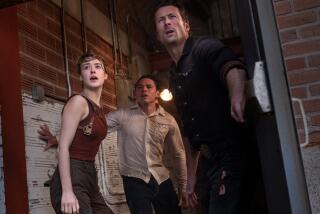Movie review: ‘The Impossible’ has the right touch with real horror
So terrifying is the 2004 tsunami as imagined in “The Impossible,” its destructive force engulfing the screen with such violent menace, that the imagery alone elicits a rising dread so intense you may feel yourself gasping for breath.
Spanish-born director J.A. Bayona must have been tempted to let the monstrous waves triggered by the Indian Ocean earthquake that devastated South East Asia and left hundreds of thousands dead overwhelm the dramatic story he tells.
That never happens in this profoundly moving film inspired by the real-life experience of the Alvarez Belon family on that fateful December day. Naomi Watts and Ewan McGregor star as Maria and Henry, on holiday with their three boys at a Thailand beach resort, and the film introduces gifted young Tom Holland as the couple’s oldest son Lucas.
Best of 2012: Movies | TV | Pop music | Jazz
Bayona achieves a rare sense of balance between the big and the powerful as well as the small and the intimate in the family’s survival against impossible odds, no doubt the inspiration for the title. Their situation was heartbreaking, their courage in the face of it humbling. It is the kind of ode to the human spirit that you hope comes along, and not just during the holiday season.
One surprise is that it took a horror auteur to pull off such a grounded film without letting the tsunami, or the sentiment, get out of control, although he had an abundance of both in Sergio G. Sanchez’s screenplay. You could argue that “The Impossible” could have benefited from more nuance in the dialogue, but that flaw only slightly dims the power of the film.
As the movie opens, Maria and Henry are on a turbulent flight with their boys, Lucas, Thomas (Samuel Joslin) and Simon (Oaklee Pendergast). A smooth landing and 24 hours later, the Christmas presents dispensed and wrapping paper crumpled on the floor, they head to the pool. Bayona uses that brief calm before the tsunami to do more than introduce us to the people whose journey we will follow.
In a handful of scenes, the director lays the framework for the way in which he will use sight and sound to define their experience. The deafening roar of the jet engines, the glassy ocean underneath it, the eerie silence that thickens in the moments before the tsunami hits, and the muffled screams of Maria when it does, are beyond even what Bayona achieved in his petrifying Cannes Film Festival debut a few years ago. “The Orphanage,” also written by Sanchez, was a far more traditional genre film, though the director’s understanding of the fear that comes with the loss of control — those moments when forces beyond you take over your fate — very much infiltrated that film too.
Best of 2012: Video Games | Art | Theater | Awesome
For his second feature film, Bayona has significantly refined the sensory sensibilities, working once again with cinematographer Oscar Faura, whose impressive background includes other unsparing examinations of the human condition, notably 2010’s “Biutiful,” with Javier Bardem, and 2004’s “The Machinist,” with Christian Bale. You believe it when the filmmakers say the eight or so minutes of the tidal wave that we see on screen was a year in preparation and a month in shooting the special and visual effects veterans Felix Berges and Pau Costa created.
Like the experience of the family separated by the tsunami, the narrative is split between Maria and Lucas’ journey and Henry’s with the two younger boys, though the mother and son arc dominates. In the panic that overtakes Maria when she surfaces to a vast churn of water and debris, alone, no sight of her family or anyone else, the odds of survival are laid out. When she spots Lucas struggling in the current, the clash between incredible hope and absolute fear surfaces. Both those emotions carry the film.
Soon it becomes clear that coming out alive is no guarantee of survival. Maria’s injuries are grave and in that moment when Lucas sees a gaping wound and whispers “Mama,” the boy becomes a man. The many ways in which Lucas is forced to grow up in just a matter of days, and Maria’s instinctive understanding that to come out of this intact she must find a way to guide her son’s choices even as she lies near death, is the real heart of the movie. Holland and Watts’ onscreen bond is one of the most poignant aspects of the film.
As is always the case in disasters like these, the road to help is paved by the care and generosity of strangers, and the movie is filled with the many small acts of kindness extended to the family along the way. The villagers who rip off a door to carry Maria, the man who lends Henry his cell phone despite the precious minutes of battery life he will lose.
Henry spends the hours after the tsunami walking through the devastation screaming Maria and Lucas’ names, McGregor channeling such grief in every labored step. Soon he is forced to trust his 5- and 7-year-old boys to others so they can go to the safety of the hills as his search for the rest of the family continues.
Miles away in an over-crowded hospital, Maria faces multiple surgeries in the crudest of circumstances. The scope of the damage and the difficult realities are woven in. Pick-up trucks carrying bodies, the makeshift message boards with names of the missing, aid workers trying to keep up with the unending string of injuries, the parentless children, the childless parents, random family photos covered in mud, final notes left behind, houses reduced to matchstick heaps, and the growing field of bodies in bags become the backdrop. It was a fine line to walk to show the extent of the disaster and its human cost without making the moments feel like exploitation. The filmmakers have handled it with a sensitivity that is respectful of the loss.
Though many people will know the ending before they walk into the theater, that doesn’t make “The Impossible” any less affecting. For it is in the details — the many ways in which fate and circumstance intervened, and what survival required of each member of the Alvarez Belon family — that you find the far better story.
PHOTOS AND MORE
VIDEO: The making of ‘Argo,’ ‘Les Miz’ and more
The Envelope: Awards Insider
PHOTOS: NC-17 movies: Ratings explained
More to Read
Only good movies
Get the Indie Focus newsletter, Mark Olsen's weekly guide to the world of cinema.
You may occasionally receive promotional content from the Los Angeles Times.










